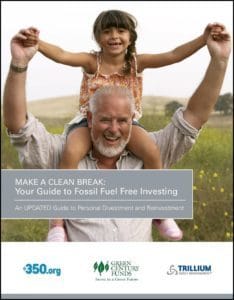Defining Fossil Fuel Free Investing
The Rockefeller Family Fund announced last month that the foundation will move as quickly as possible to divest from fossil fuels. In doing so, they joined actor and climate change activist Leonardo DiCaprio and the Rockefeller Brothers Fund (a separate foundation), as well as thousands of individuals and hundreds of organizations who have already committed to divesting from fossil fuel companies.
But what does it mean to invest fossil fuel free? And how do you begin to divest? This post will attempt to clarify the definition of fossil fuel free investing, and to distinguish between fossil fuel free and low carbon investment strategies.
What does it mean to invest fossil fuel free?
For Green Century, and for many other leaders in the fossil fuel free investing movement, investing fossil fuel free has a very clear definition: it means no investing in companies whose only, core, or majority business is the exploration, extraction, refining, processing, or distribution of fossil fuels. In addition, we think that a fund or product cannot invest in any utility who primarily burns fossil fuels. It is important that these specifications be included in a Fund company’s prospectus, as that is the only way to guarantee a fund follows this or any specific investment strategy.
For Green Century, like many other investors, we first divested for ethical reasons. As more reports have been published about fossil fuel free investing, the potential financial advantages – such as a fossil fuel company’s capital expenditures, the high cost of oil drilling, and the possibility of holding stranded assets – have become more known.
So no fossil fuel companies or fossil fired utilities. What about changing the definition of ‘fossil fuel free’ to include companies that use fossil fuels?
We don’t think that this is that wise or useful, and it makes it difficult to create a specific definition of fossil fuel free. For example, does this definition include any companies that use fossil fuels for production? Include those companies, but eliminate others who have not improved the fuel efficiency of their trucking fleet? Just exclude a certain type of company, like airlines? Plus, while fossil fuel free is a fast growing movement, it still has a long way to go and changing the definition may exclude the investors that we need to join the divestment campaign.
But, what about the carbon emissions of a company?
That’s a different story! Pressing companies to reduce their carbon pollution is very important – and having a fund company know its carbon footprint is a key step that we’ve supported for a long time. In fact, the Green Century Balanced Fund was the first U.S. mutual fund to do a carbon footprint.
And what about “low carbon” funds?
That can be tricky. There is no regulated or standard definition for “low carbon” at the moment, so it is largely a marketing term – akin to using “natural” for food to imply it is organic when it may not be. And “low carbon” is not interchangeable with “fossil fuel free.” A mutual fund might have investments in coal, oil and gas companies and still call itself “low carbon” – so an investor needs to check energy sector exposure and the specific companies.
What about investing in clean and renewable energy – how does that fit into fossil fuel free?
A fund that avoids coal oil and gas companies does not necessarily invest in clean energy. But many – including Green Century – do. Check the specific companies that are part of that fund. You can also ask if and how a fund supports clean energy policy through its lobbying or shareholder advocacy.
So how do I get started investing fossil fuel free?
If you are looking for information on how to get started divesting, these resources may be of help:
- Green Century’s Updated Personal Guide to Divestment
- How to Add Fossil Fuel Free Options to Your 401(k)
- 350.org
- GoFossilFree.org
- DivestInvest.org
Click here to view the current holdings of the Green Century Funds. Portfolio composition will change due to ongoing management of the Funds. References to specific securities or sectors should not be construed as recommendations by the Funds, their Advisor, or their Distributor.
Stocks will fluctuate in response to factors that may affect a single company, industry, sector, or the market as a whole and may perform worse than the market. Bonds are subject to a variety of risks including interest rate, credit, and inflation risk. The Funds’ environmental criteria limit the investments available to the Funds compared to mutual funds that do not use environmental criteria.
You should carefully consider the Funds’ investment objectives, risks, charges and expenses before investing. To obtain a Prospectus that contains this and other information about the Funds, please click here for more information, email info@greencentury.com or call 1-800-93-GREEN. Please read the Prospectus carefully before investing.
This information has been prepared from sources believed to be reliable. The views expressed are as of the date of this writing and are those of the Advisor to the Funds.
The Green Century Funds are distributed by UMB Distribution Services, LLC, 235 W. Galena Street, Milwaukee, WI 53212. 4/16



